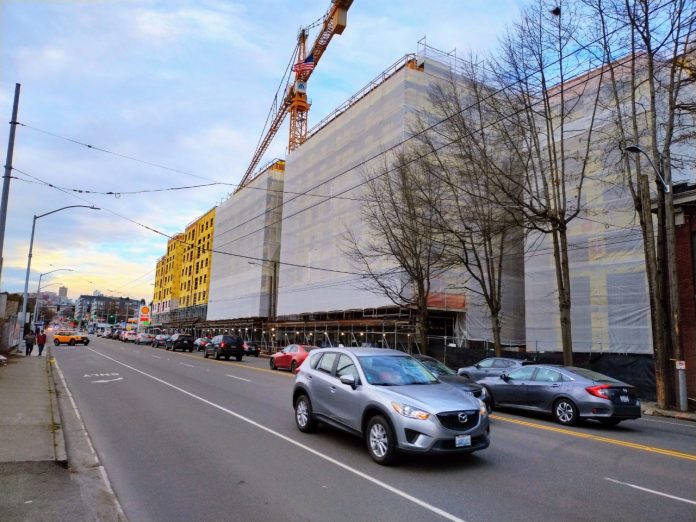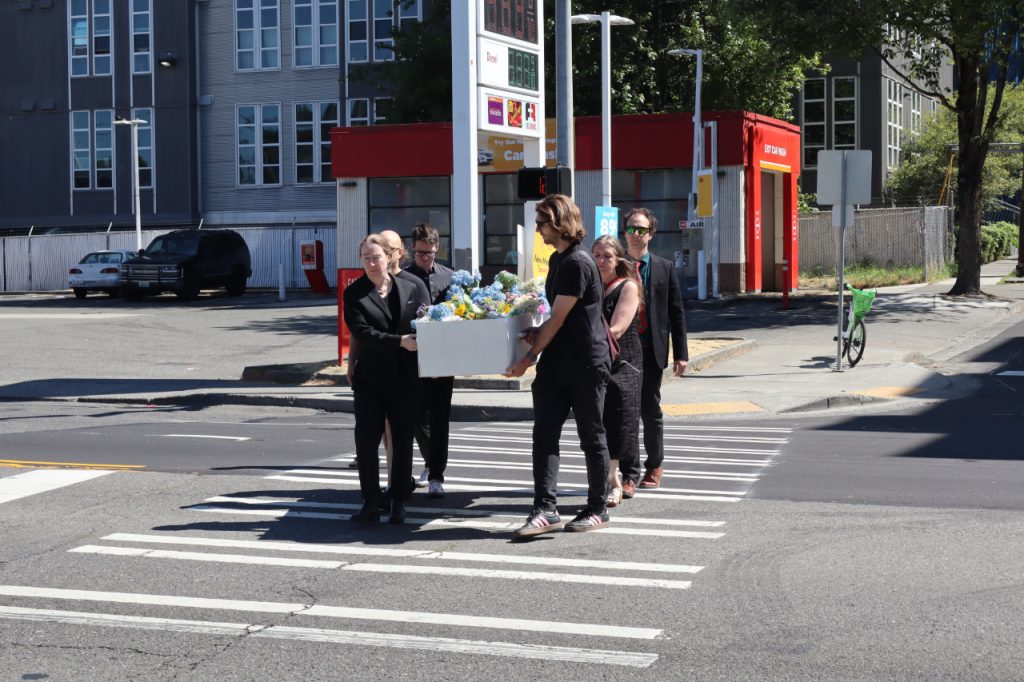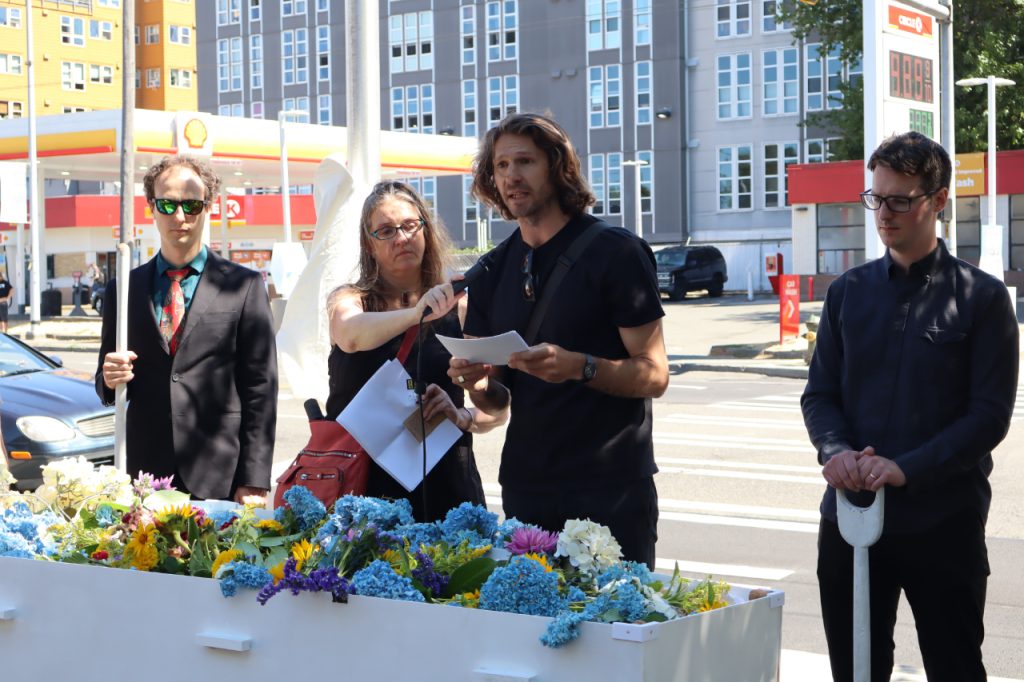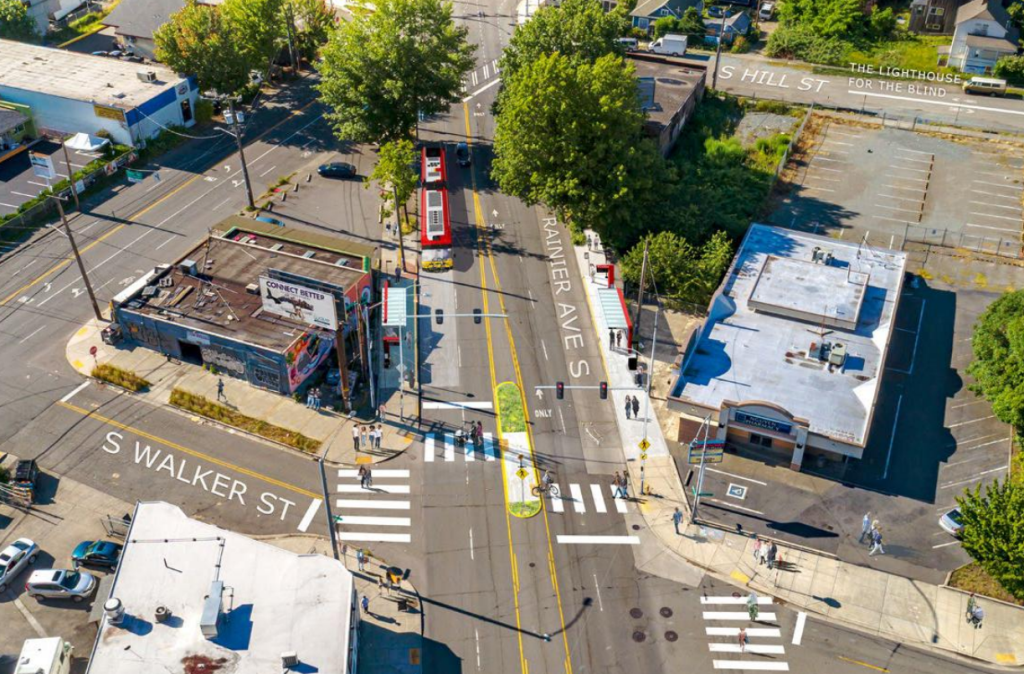
If you’re travelling Seattle’s streets looking for signs of changes stemming from the city’s new transportation levy, think small. Following the approval of the eight-year, $1.55 billion measure last November, crosswalks are getting repainted, sidewalks are getting repaired, and trees are getting planted. Despite an increase in the total size of the new levy over the city’s last transportation levy, the new workplan includes many more small-scale upgrades and spot improvements, and fewer big-ticket projects.
But some major corridor overhauls are on the way. Among them, one of the new levy’s biggest tests will be Rainier Avenue S. Despite over a decade of attention to the street from various Seattle Department of Transportation (SDOT) projects, the corridor remains one of the most dangerous in the city.
Earlier this month, traffic safety advocates gathered at Rainier Avenue S and S Charles Street to demand immediate city action to improve safety on the corridor, which has seen 1,522 traffic crashes resulting in a serious injury or death along its entire length over the past decade. Of particular focus is the northern segment, where traffic volumes are highest and where thousands of housing units have opened or are in development.
Right in the middle of the area is Sound Transit’s Judkins Park Station, which is poised to open next year and bring a significant amount of new foot traffic and bike trips.

Dramatically illustrating the fact that without city action, devastating impacts will continue, the group slowly carried a white coffin filled to the brim with flowers across the wide expanse of street. At the intersection, they mounted a small mirror — showing which Rainier Avenue traveler could find themselves becoming the next statistic — and a white shovel.
“When a community gathers around individuals with shovels, they are usually witnessing either a funeral or a groundbreaking ceremony,” Kyle Jacobson, a volunteer with Central Seattle Greenways and an organizer of the event, told attendees. “With our event today, we remind you of the grim truth that still more Seattle families will be digging to mourn loved ones who could have been spared from death on our streets. And with our event today and with this memorial, we ask, when will Seattle’s leaders pick up shovels to break ground on a safe streets megaproject with Rainier Ave S at its heart?”

The new levy makes big promises around Rainier Avenue. Few places in the city have more projects directly spelled out in the levy’s project list, the Attachment A approved by the city council when they sent the package to the ballot. Those include a corridor-wide safety project, a major maintenance project from S Walden St to S Jackson St, and the only RapidRide bus corridor upgrade planned in the levy’s eight years, the R Line.
The 2025 levy delivery plan, released earlier this year, confirms that the department has started planning work on many of these projects, while planning some smaller-scale upgrades to the street. Most of those are along Rainier’s southern stretch
But the Move Seattle Levy approved by voters in 2015 also promised upgrades to Rainier. And while that levy did result in some major improvements across the city, that failure to follow up on the Rainier Valley’s most important street undeniably hurt the city’s reputation around safety.
If a second levy can’t actually finish the job, that would represent a major black eye for the city, and solidify the impression that the Rainier Valley is an afterthought for policymakers. Despite Seattle’s espoused commitments to racial equity, the most racially diverse area of the city continues to see a disproportionate share of traffic violence and an avenue with a deadly, crash-prone design continues to run through the heart of it.
“We would like to see the city go really big and bold with it,” Seattle Neighborhood Greenways Community Organizer Clara Cantor said at the curbside event on Rainier.
There appears to be political support behind major changes, with three of the four candidates vying to represent District 2 showing up to the press event this month. The fourth, Adonis Ducksworth, has made traffic safety a centerpiece of his campaign after working on the issue for years in Mayor Bruce Harrell’s office.
“As we’ve seen with the previous levy, I think that there’s a really high opportunity there,” Cantor continued. “There’s also a tendency for the city to water down projects to make do with a little bit of paint, a little bit of spot fixes here and there, and call that done, and check the box off because they [say] we accomplished what we promised in the levy. And that’s not going to work, because there are people that are dying. There are people that are being injured.”

With a confluence of projects along Rainier, the city has the opportunity to make near-term safety investments while at the same time designing a future street that’s built for people. Building on Madison Street’s RapidRide G Line as a corridor upgrade that went beyond a normal transit project and truly transformed how the street works for everyone, the future RapidRide R Line would undoubtedly be at the center of this work.
In 2020, when the R Line was put on hold due to lack of funding, early concepts had been developed that mostly left Rainier in its current form, upgrading stops and adding crossing improvements that would benefit riders when they’re directly accessing transit. Sending SDOT and Metro back to the drawing board could be a blessing in disguise, with new levy money combining with other sources to go bolder.

The stakes here are incredibly high, in a city that has had a goal of eliminating deaths and serious injuries on its roadways for a full decade.
“A member of our community has been injured or killed in a car crash on Rainier Avenue South every two and a half days, on average, for the last 10 years,” Jacobson said. “Unless Seattle’s leaders act with alacrity and purpose, members of our community will continue to be injured or killed on Rainier.”
If the city cannot leverage the $1.55 billion levy backed by traffic safety advocates and resoundingly approved by voters last fall to create a Rainier Avenue that’s safe for everyone, then the entire package can reasonably be called into question.
“This is our community, and it needs to be done better than that,” Cantor said. “We deserve better than that.”
Seattle Neighborhood Greenways has created an action alert to push city leaders to act on making Rainier Avenue safer for all.
Ryan Packer has been writing for The Urbanist since 2015, and currently reports full-time as Contributing Editor. Their beats are transportation, land use, public space, traffic safety, and obscure community meetings. Packer has also reported for other regional outlets including BikePortland, Seattle Met, and PubliCola. They live in the Capitol Hill neighborhood of Seattle.

